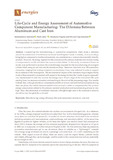JavaScript is disabled for your browser. Some features of this site may not work without it.
| dc.contributor.author | Salonitis, Konstantinos | |
| dc.contributor.author | Jolly, Mark R. | |
| dc.contributor.author | Pagone, Emanuele | |
| dc.contributor.author | Papanikolaou, Michail | |
| dc.date.accessioned | 2019-07-19T15:54:55Z | |
| dc.date.available | 2019-07-19T15:54:55Z | |
| dc.date.issued | 2019-07-03 | |
| dc.identifier.citation | Salonitis K, Jolly M, Pagone E and Papanikolaou M., Life cycle and energy assessment of automotive components manufacturing: The dilemma between aluminium and cast iron. Energies, Volume 12, Issue 13, 2019, Article Number 2557 | en_UK |
| dc.identifier.issn | 1996-1073 | |
| dc.identifier.uri | https://doi.org/10.3390/en12132557 | |
| dc.identifier.uri | https://dspace.lib.cranfield.ac.uk/handle/1826/14368 | |
| dc.description.abstract | Considering the manufacturing of automotive components, there exists a dilemma around the substitution of traditional cast iron (CI) with lighter metals. Currently, aluminum alloys, being lighter compared to traditional materials, are considered as a more environmentally friendly solution. However, the energy required for the extraction of the primary materials and manufacturing of components is usually not taken into account in this debate. In this study, an extensive literature review was performed to estimate the overall energy required for the manufacturing of an engine cylinder block using (a) cast iron and (b) aluminum alloys. Moreover, data from over 100 automotive companies, ranging from mining companies to consultancy firms, were collected in order to support the soundness of this investigation. The environmental impact of the manufacturing of engine blocks made of these materials is presented with respect to the energy burden; the “cradle-to-grave approach” was implemented to take into account the energy input of each stage of the component life cycle starting from the resource extraction and reaching to the end-of-life processing stage. Our results indicate that, although aluminum components contribute toward reduced fuel consumption during their use phase, the vehicle distance needed to be covered in order to compensate for the up-front energy consumption related to the primary material production and manufacturing phases is very high. Thus, the substitution of traditional materials with lightweight ones in the automotive industry should be very thoughtfully evaluated | en_UK |
| dc.language.iso | en | en_UK |
| dc.publisher | MDPI | en_UK |
| dc.relation.ispartofseries | ;2557 | |
| dc.rights | Attribution 4.0 International | * |
| dc.rights.uri | http://creativecommons.org/licenses/by/4.0/ | * |
| dc.subject | energy efficiency | en_UK |
| dc.subject | life-cycle assessment | en_UK |
| dc.subject | aluminum | en_UK |
| dc.subject | cast iron | en_UK |
| dc.title | Life cycle and energy assessment of automotive components manufacturing: The dilemma between aluminium and cast iron | en_UK |
| dc.type | Article | en_UK |
Files in this item
The following license files are associated with this item:
This item appears in the following Collection(s)
-
Staff publications (SATM) [4367]

